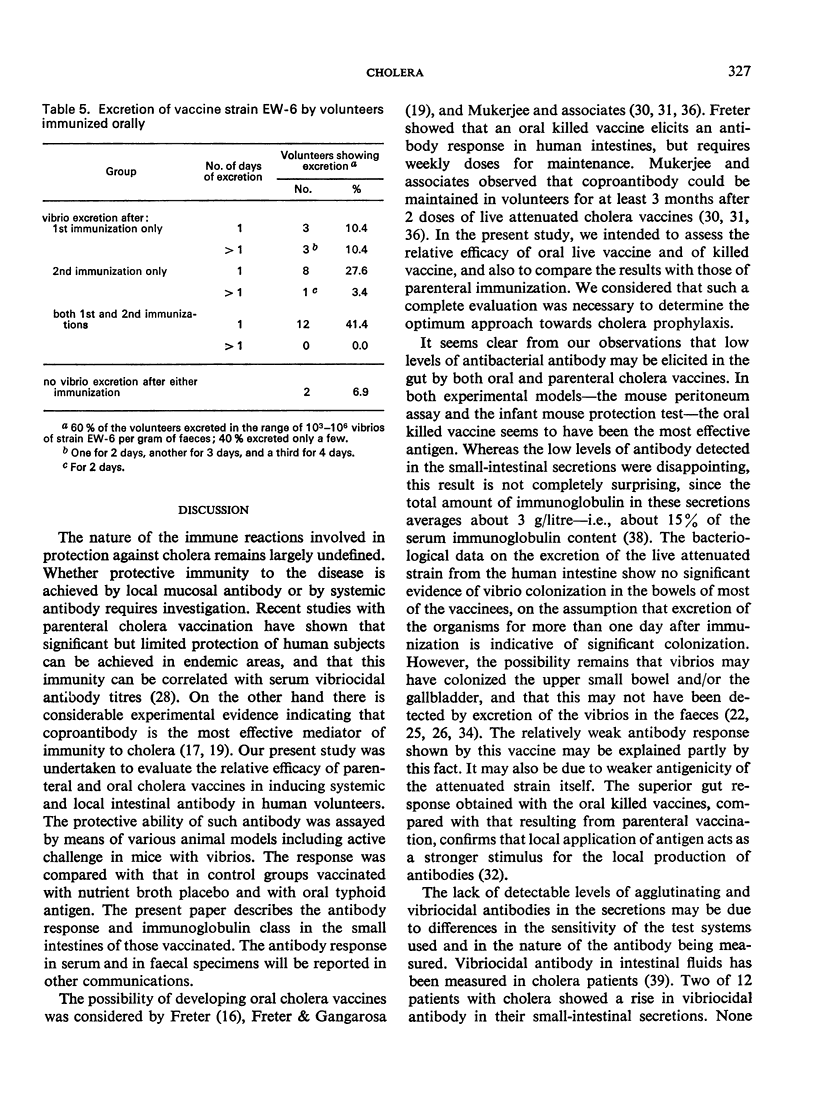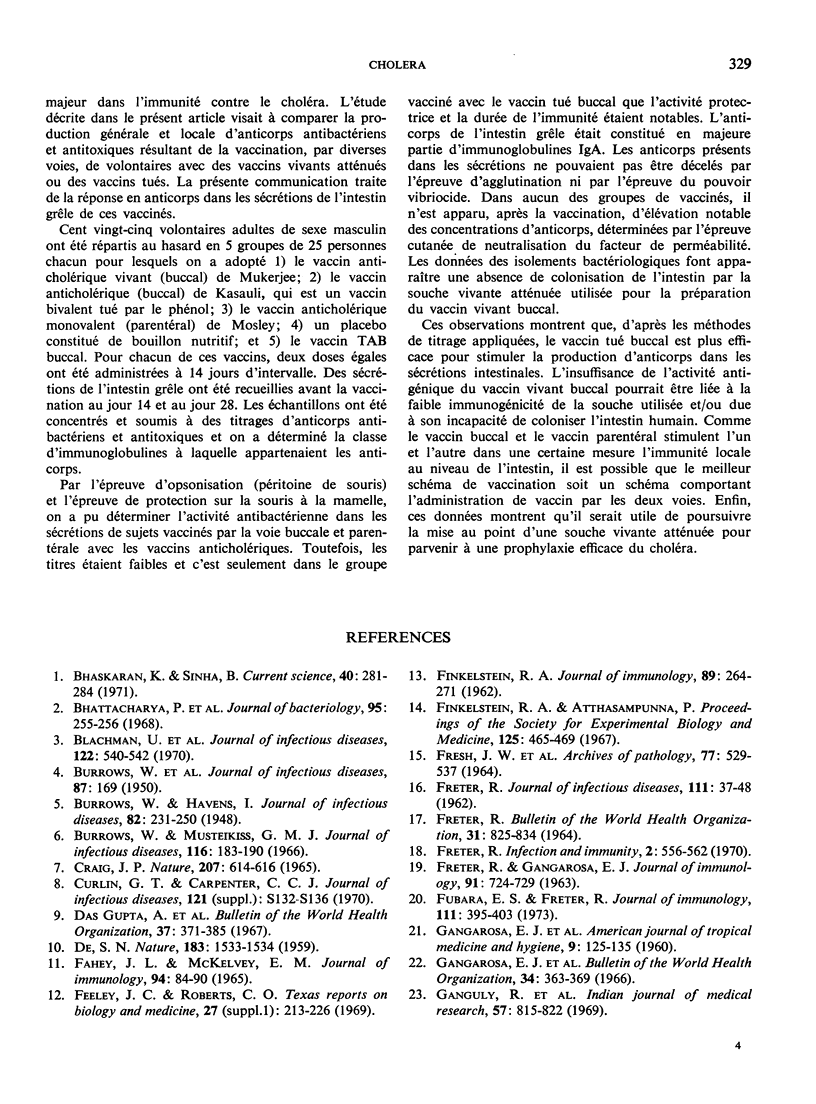Abstract
The efficacy of various cholera vaccines in eliciting an intestinal antibody response was assessed in human volunteers who received oral live, oral killed, or parenteral cholera vaccines, or placebo. The intestinal immune response in terms of antibacterial and antitoxin antibodies was determined 2 and 4 weeks after immunization. By means of the mouse peritoneum opsonization assay and the infant mouse protection test, antibacterial activity could be detected in the intestinal secretions of volunteers who had been immunized either orally or by the parenteral route. Significant protective activity and duration of immunity were observed with the oral killed vaccine. The bacteriological data indicated the absence of significant intestinal colonization of the live attenuated strain after oral administration, and probably explains the observed lack of effectiveness of the oral vaccine compared with that of the killed vaccine. The predominant immunoglobulin class of intestinal antibody was found to be IgA. None of the vaccines used in the study elicited significant antitoxin activity in the intestinal secretions, as determined by the skin permeability neutralization test.
Full text
PDF







Selected References
These references are in PubMed. This may not be the complete list of references from this article.
- Bhattacharya P., Narayanaswami A., Mukerjee S. Production of antitoxic immunity by live oral cholera vaccine. J Bacteriol. 1968 Jan;95(1):255–256. doi: 10.1128/jb.95.1.255-256.1968. [DOI] [PMC free article] [PubMed] [Google Scholar]
- Craig J. P. A permeability factor (toxin) found in cholera stools and culture filtrates and its neutralization by convalescent cholera sera. Nature. 1965 Aug 7;207(997):614–616. doi: 10.1038/207614a0. [DOI] [PubMed] [Google Scholar]
- DE S. N. Enterotoxicity of bacteria-free culture-filtrate of Vibrio cholerae. Nature. 1959 May 30;183(4674):1533–1534. doi: 10.1038/1831533a0. [DOI] [PubMed] [Google Scholar]
- Das Gupta A., Sinha R., Shrivastava D. L., De S. P., Taneja B. L., Rao M. S., Abou-Gareeb A. H. Controlled field trial of the effectiveness of cholera and cholera El Tor vaccines in Calcutta. Bull World Health Organ. 1967;37(3):371–385. [PMC free article] [PubMed] [Google Scholar]
- FAHEY J. L., MCKELVEY E. M. QUANTITATIVE DETERMINATION OF SERUM IMMUNOGLOBULINS IN ANTIBODY-AGAR PLATES. J Immunol. 1965 Jan;94:84–90. [PubMed] [Google Scholar]
- FRESH J. W., VERSAGE P. M., REYES V. INTESTINAL MORPHOLOGY IN HUMAN AND EXPERIMENTAL CHOLERA. Arch Pathol. 1964 May;77:529–537. [PubMed] [Google Scholar]
- FRETER R., GANGAROSA E. J. ORAL IMMUNIZATION AND PRODUCTION OF COPROANTIBODY IN HUMAN VOLUNTEERS. J Immunol. 1963 Dec;91:724–729. [PubMed] [Google Scholar]
- Freter R. Mechanism of Action of Intestinal Antibody in Experimental Cholera II. Antibody-Mediated Antibacterial Reaction at the Mucosal Surface. Infect Immun. 1970 Nov;2(5):556–562. doi: 10.1128/iai.2.5.556-562.1970. [DOI] [PMC free article] [PubMed] [Google Scholar]
- Fubara E. S., Freter R. Protection against enteric bacterial infection by secretory IgA antibodies. J Immunol. 1973 Aug;111(2):395–403. [PubMed] [Google Scholar]
- Gangarosa E. J., Saghari H., Emile J., Siadat H. Detection of Vibrio cholerae biotype El Tor by purging. Bull World Health Organ. 1966;34(3):363–369. [PMC free article] [PubMed] [Google Scholar]
- Ganguly R., Deb B. C., Shrivastava D. L. Vibriocidal test and its parameters. Indian J Med Res. 1969 May;57(5):815–822. [PubMed] [Google Scholar]
- Kasai G. J., Burrows W. The titration of cholera toxin and antitoxin in the rabbit ileal loop. J Infect Dis. 1966 Dec;116(5):606–614. doi: 10.1093/infdis/116.5.606. [DOI] [PubMed] [Google Scholar]
- Ogra P. L., Karzon D. T. Poliovirus antibody response in serum and nasal secretions following intranasal inoculation with inactivated poliovaccine. J Immunol. 1969 Jan;102(1):15–23. [PubMed] [Google Scholar]
- Oza N. B., Dutta N. K. EXPERIMENTAL CHOLERA PRODUCED BY TOXIN PREPARED BY ULTRASONIC DISINTEGRATION OF VIBRIO COMMA. J Bacteriol. 1963 Feb;85(2):497–498. doi: 10.1128/jb.85.2.497-498.1963. [DOI] [PMC free article] [PubMed] [Google Scholar]
- Pierce N. F., Banwell J. C., Gorbach S. L., Mitra R. C., Mondal A., Manji P. M. Bacteriological studies of convalescent carriers of cholera vibrios. Indian J Med Res. 1969 Apr;57(4):706–712. [PubMed] [Google Scholar]
- Sanyal S. C., Mukerjee S. Live oral cholera vaccine: report of a trial on human volunteer subjects. Bull World Health Organ. 1969 Apr;40(4):503–511. [PMC free article] [PubMed] [Google Scholar]
- Waldman R. H., Wigley FM Small P. A., Jr Specificity of respiratory secretion antibody against influenza virus. J Immunol. 1970 Dec;105(6):1477–1483. [PubMed] [Google Scholar]


